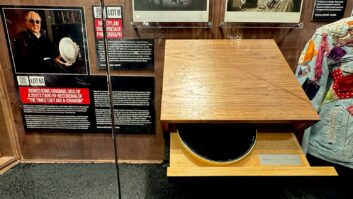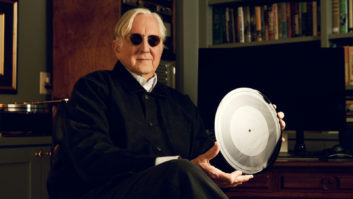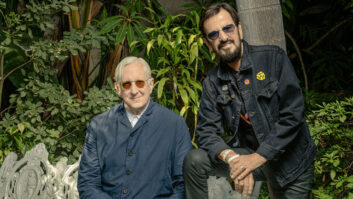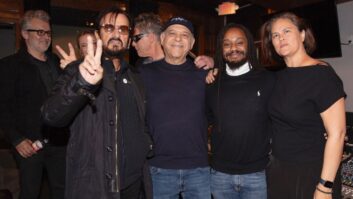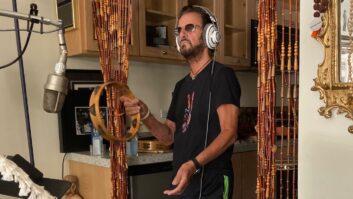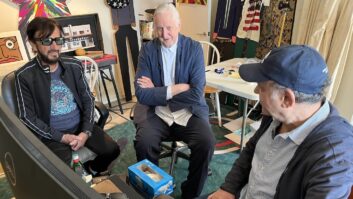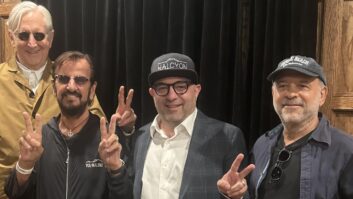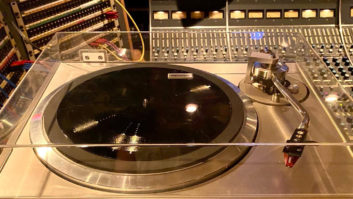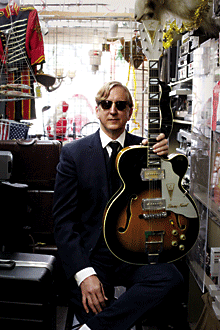

I’ve been rooting for T Bone Burnett to succeed almost as long as I’ve been writing about music. Back in 1977, I fell in love with the music of a Los Angeles — based group called the Alpha Band. The three principals — Burnett, David Mansfield and Steven Soles — had been members of Bob Dylan’s Rolling Thunder Review, and once that disbanded, they recorded three eclectic albums of highly literate songs that were infused with a strong underlying morality and were peppered with irony. I loved Burnett’s dry wit, his gift for sketching intriguing characters and his uncanny ability to mix his musical roots in rockabilly, folk and Texas R&B into a sound that was both original and compelling.
Burnett became something of a critic’s darling. He put out a number of albums during the early ’90s, each a gem in its own way, but none was commercially successful. It didn’t matter; at the same time, Burnett became one of the most intriguing producers working out of L.A. He helmed Los Lobos’ magnificent early albums; Roy Orbison’s swan song, Mystery Girl (as well as the all-star TV tribute to him, A Black & White Night); two of Elvis Costello’s best middle-period albums, King of America and Spike; The Wallflowers’ Bringing Down the Horse; the Counting Crows debut, August and Everything After; and multiple albums with Gillian Welch, Bruce Cockburn and the talented singer/songwriter Sam Phillips (who was also married to Burnett for a number of years).
During the past few years, Burnett has become renowned for his work as music producer and/or supervisor for films, including O Brother, Where Art Thou?, whose soundtrack sold many millions, sparked a revival of old-time country music and earned an armful of Grammys, including Album of the Year and Best Producer for Burnett. No less stimulating, though, was the music he dug up and produced for the Civil War drama Cold Mountain, The Ladykillers (featuring lots of great Southern gospel music) or Walk the Line. It was Burnett who schooled Joaquin Phoenix and Reese Witherspoon, and assembled and produced the music (in addition to writing the original score).
Now, 14 years after his last solo album and riding the wave of respect and success he’s earned in the production world, Burnett has put out a new album of his own songs, The True False Identity. Fronting a band with three percussionists (including monster drummer Jim Keltner), a stand-up bassist (Dennis Crouch) and the great textural guitarist Marc Ribot (among others), Burnett unleashes a dozen tunes that range from the spoken-word fable “Palestine Texas” to hard reggae and raging metal-tinged workouts. Also out this year is a two-CD anthology, Twenty Twenty: The Essential T Bone Burnett, which captures 40 songs from his earlier albums. Burnett and I spoke in mid-May, just before he was to embark on a tour supporting both new releases.
One of the things that’s interesting about Twenty Twenty is that it isn’t chronological; it freely mixes songs from different albums and different periods, yet it doesn’t feel disjointed.
Well, I’ve never really settled on a style, and I’ve also never really been part of the mainstream, so most of my songs don’t sound tied to an era.
You didn’t have a period when you had wheedling synthesizers, for instance?
[Laughs] No, I didn’t. Still, records are documents of a period of time. Most records are documents of two or three years, and I just approached it as a record I was doing over a 20-year period of time.
What did you think as you went through your body of work?
It was fun! The last 10 years I’ve been through a Master’s Class in the arts, and I had some time — maybe six or eight years — when I hadn’t really listened to anything I had done in the past. So I had enough time to view it without the sort of narcissistic jaundice that I generally look at the things I do with, and I was happy to be able to find as many tunes as I did that I could still stay in the room with. A lot of them I actually dug quite a bit.
Somewhere along the way in the last several years, I remembered an album by Ike and Tina Turner that was recorded in the Skyliner Ballroom, which is the room on Jacksboro Highway in Fort Worth [Texas] that I cut my teeth in. It was an old-time, 1930s ballroom that had turned into a juke joint by the time I was a kid. I started going out there when I was about 14 and hearing Junior Parker and Bobby Bland, and Wayne Bennett was the guitar player, Ray Sharp was the house band. He had a song called “Linda Lu” [which Burnett recorded in 1972; it’s not represented on Twenty Twenty]. Anyway, what I realized is that the way that room sounded, to me, is the sound I’ve been going for on every record I’ve ever done, and I’ve just learned more and more about how to do it. It’s been a long time of figuring out how to make it sound as exciting on a record or in a room as music sounded to me at that time. I’ve always gone for that subconsciously; now I’m doing it consciously.

When it came to recording your new album, The True False Identity, is the sound on there something you envisioned for that particular batch of songs while you were writing them?
It all grew together — the sound and the songs. It all began when I started writing for [the new version of] The Tooth of Crime and the challenges of doing music for that medium. In the theater, music has to be powerful and compelling, but it can’t overwhelm the spoken word that comes before and/or after it. It’s a completely different approach to sound than the normal rock ‘n’ roll approach to sound, which is turn it up until it hurts, then turn it up a little bit more. [Laughs]
Well, a lot of this album is pretty cranked up, I’d say.
It is, but in a different way. All the music was played incredibly quietly [in the studio]. It’s something I learned from Roy Orbison. Orbison never opened his mouth more than half an inch, and if you were standing 10 feet away when he sang, you could barely hear him. Nevertheless, when you turned it up, it sounded like he was singing an aria or something because it was all tone and it was supported so powerfully by who he was and the way he learned to do it. So that’s part of the process I’ve been through — turn it down to three, but fill that three with so much intensity that if you turn it up to 10, it’s five times louder than it would’ve been the other way.
I love loud music. I listen loud, and that’s part of how I’ve learned how to do this. Record softly and play back loud and a whole other thing happens.
You have an interesting approach to percussion on this album. There are all these layers — occasionally things that sound like shells or something. It reminds me of something Tom Waits would do.
I started working under the premise that all instruments are drums of a sort. All instruments are resonating chambers that you attack with either your breath or a stick or a bow. It’s all attack and resonance, and what we’ve been doing is minimizing attack and maximizing resonance, which is exactly the opposite of what most recording has been for the last 30 or 40 years, where everything is focused on the attack and everything is put exactly on the beat and all of the resonance is minimized or — in the case of synthesizers, where things are pure sine waves — the overtones are completely done away with. Well, it’s my belief and my understanding that the most interesting part of sound is not the attack, which is very short, but it’s the tone and the overtones and then the music that’s created within the overtones by the overtones themselves — the things you lose control over. So much of recording is about gaining control over sound, and what we’ve been doing for the last 10 years — really, more like 20 years, but intensely the last 10 with my collaborator, [engineer] Mike Piersante — is seeking out the things we can’t control and working with those.

You guys have worked together for quite a long time.
Mike is one of the most talented people I know and one of the most honest. He’s a great recordist. In fact, I think by this point, he’s in a class by himself. There isn’t anybody who does quite what he does.
Was this album cut essentially live in the studio?
It was cut completely live. On the whole record there are probably a handful of overdubs. There were a few vocal lines I re-did or added, and then there are a couple of guitar solos.
Tell me about the evolution of your production career. You had the opportunity to work with a lot of cool, younger bands as they were coming up: Los Lobos, Counting Crows, The Wallflowers. What do you think you brought to those sorts of projects?
I’m not quite sure. But I know I brought more to them as I went along. And I do know this: I always wanted whatever I was doing to be art, so I was always fighting for those records to measure up to a standard of how I felt when I heard The Kinks for the first time or Ray Charles for the first time. From an early age, I knew I wasn’t as good as the other things I was hearing, but I was always trying to get there. David Hidalgo [of Los Lobos] is incredibly talented, and I thought, “David Hidalgo can get to that point; he can be as good in his own way as Miles Davis or Ray Charles.” So what I was willing to do was wait until the record sounded as good to me in its own way as the first time I heard “Lonely Avenue” by Ray Charles. I would try to be true to that feeling — the effect that music had on me.
Did you feel more like a documentarian than a shaper and arranger?
I would like to have. I was always happiest when that was my role. There were times working with young bands when they were too inexperienced to do it as a documentarian, when they really needed some help, and I’m happy to do that, too. I usually have a few ideas. [Laughs] You know, lately I’ve worked with people like Tony Bennett and Ralph Stanley — these masters — and there you are more of a documentarian. You’re there to help them get ready — whatever that’s going to take — and to encourage them and make sure the tape’s rolling when they start.
Or, when you were working with someone like Elvis Costello, he was obviously a full-blown talent, to say the least.
That’s right, and that’s a case where both of us were exploding with imaginative ideas. Both of us wanted to do things that hadn’t been done before. He always said, “I want to write my own clichés,” and when we did King of America, Elvis was wanting to rediscover American music for himself and for all of us. He felt there was a lot of great American music that’s not heard, not understood, that’s disparaged, and he wanted to raise that standard. At the time, he was viewed as a sort of enfant terrible or something. And with Spike, we were trying to carry on that bold tradition of English record-making that had started maybe with [The Beatles’] Rubber Soul or Revolver, where we would do songs where he would do things like sing vocals on three different days with three completely different voices and then use all three at different times.
Are there albums you worked on that you put your heart and soul into but for whatever reason they didn’t pan out commercially — aside from your own, of course!
[Laughs] There were several of Sam Phillips’ records that fit into that. I hold Sam in absolutely the highest regard. She’s one of the most extraordinarily talented people I’ve ever known. I think Fan Dance and A Boot and a Shoe were underheard. I made a beautiful record with Peter Case that I think was under-heard, as well.
Well, it’s nearly impossible to predict what the public will like. Much as I love Gillian Welch, I wouldn’t have thought she would enjoy as much commercial success as she has.
That’s right, and that sort of thing does happen. Like Gillian, I was always one of those people who didn’t fit into any cultural trends, and Sam was that, too. Sam Phillips and I have both been sort of men without a country our whole lives, although at this point, I feel like I’ve sort of landed somewhere. It’s not where I thought I might be, but at least I feel like I’ve got some ground under my feet now.
Do you find that people expect you to have some fixed aesthetic?
I think I know what you mean, and the answer is yes.
Tube mics, retro, whatever…
Right. And that is true to an extent. I mean Mike and I use the lowest tech and the highest tech. We don’t use much in between. We’ll use an old Rickenbacker amplifier that was put together by a woman who learned to solder during the Second World War. But then we also use all Class-A electronics. And when we use the computer, we use 192k. I try to use the technology in a way that it’s either absolutely transparent or it’s absolutely apparent; any of the middle ground is distracting, I think.
Has the success of O, Brother affected how people perceive you or what they expect of you?
I’m sure it affected that a lot because people are impressed…
By success! But at least it was an honest success; a non-hype success, which is incredibly rare in this culture.
That’s true. It really did just happen. John Grady and Denise Stiff were the motors that drove that thing, but it was just the three of us; it was a true grassroots event from the beginning.
It must have been incredibly gratifying.
It was so deeply gratifying. It’s the one time in my life that I’ve worked on something and had everything go right for a long period of time, and for that I am deeply, deeply grateful. It was three or four years of everything going right.
What’s it like to be around Ralph Stanley for weeks at a time? You toured with him, made records with him.
Ralph is a very courtly, formal, old-world kind of character. He’s imposing.
Well, he’s a giant.
That’s right. Even though physically he’s not a giant, his persona is a giant. And as a giant, as you get to know him, he’s incredibly kind and loving and gentle. For me, getting to sit in a room and be around what he is was like going to another planet. [Laughs]
How much do you enjoy the research process that would be involved in something like Cold Mountain or The Ladykillers, where you’re digging through obscure songs to fit the mood of the film?
Well, it feels like license to kill, actually! [Laughs] They were paying me to listen to a century of gospel music or a century of American traditional music. It’s been an incredible education.
You know, the thing that struck me about Civil War music was how bloody it was; it was full of hatred. There was incredible vitriol in it. It makes Neil Young’s new record [Living With War] sound like nursery rhymes — and I don’t mean that to in any way diminish Neil Young. I’m so grateful to him, and I have such deep admiration and respect for Neil Young. But my point is these Civil War songs were gruesome. The hatred that’s so bad in this country today, and for the past 10 or 15 years, bad as it is, is nothing compared to the kind of things people would write down and sing back in the Civil War.
Are you working on any films right now?
Yes, I’m working with Julie Taymor [Titus] on a film called Across the Universe, which is the story of the 1960s told through 30 Beatles songs, which is an incredible challenge. One of the interesting things about approaching The Beatles’ material is [John] Lennon and [Paul] McCartney composed the songs, but they all composed the music together; the song was all of them, and every guitar note, every drum beat, every bit of The Beatles’ records are part of the composition, and if you remove part of it, the whole thing starts collapsing on itself. It’s the tone of their voices, the sound of the guitars, every little bit of it.
So we took on the challenge of covering these songs with these young actors. It’s a very interesting movie.
So what exactly is your role there?
Well, Teese Gohl and Elliot Goldenthal, who is Julie Taymor’s husband and a brilliant composer, are producing the music. It’s such a great volume of music that it really takes all three of us. So I’m one of the collaborators. We’re deconstructing it madly. I don’t know how far we’ll get with it. I’d like to deconstruct it completely. These kids sing so beautifully, you almost don’t need any orchestration or instrumentation with them.
It’s tough because if you do a song too much like The Beatles, it just invites a negative comparison because, hey, it’s not The Beatles.
That’s true. Almost everything The Beatles did was great, and it’s hard to improve on. They were our Bach. The way to get around it may be to keep it as simple as possible.
Let’s close by talking a little about your studio, where you and Mike do a lot of work.
I’ve got an old API board out of Sunset Sound Studio One [L.A.]. This is one from 1968. The Doors cut on it, and Led Zeppelin IV and [the Rolling Stones’] Exile on Main Street. Tons of Little Feat. It’s a storied board.
The tubes are glowing!
It’s superbad! [Laughs] It’s like having a killer old Fender Tweed amp times 32. It’s sort of the center of the workspace. We start with analog and we’ve got all the LA-2As and Pultecs and all that stuff, but there are also a lot of plug-ins we use. There are a lot of good Pro Tools plug-ins. Pro Tools has really been great for working for film. The way they did film before Pro Tools is horrifying!
Cutting mag…
Cutting mag with scissors and not worrying about it: “Oh, there’s a bad edit here, somebody cough!” [Laughs]
So you weren’t reticent about diving into the digital world.
Well, I put it off as long as I could. It didn’t sound good for a long time. Until they got the resolution up enough, I didn’t think it sounded right. It’s still sampling. I always go back to tape at the end because somehow once it goes into waveforms and out of the digital off/on switch, it gets knit back together and it doesn’t tax the ear the way digital sound does. I’ve seen a study in the last year that digital sound actually induces stress in the listener. One of the problems with digital is that they brick wall — limit it right up to the highest peak and remove all dynamics, and that makes it fatiguing. It’s also ironic that in the old days of tape and tape hiss and vinyl records and surface noise, we were always trying to get records louder and louder to overcome that.
Now, when there’s no longer surface noise and you actually have the ability to have the most extraordinary dynamic range, people aren’t using it. So on my records, I’m always fighting against that. I’ll do whatever it takes, old or new technology, to get the sound I hear in my head.
Blair Jackson is the senior editor of Mix.

